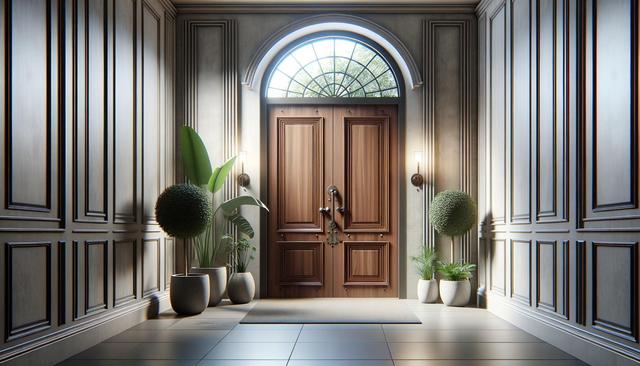Choosing the Right Entry Door Material
One of the first considerations when exploring front door options is selecting the right material. Entry doors are available in a range of materials, each offering unique advantages in terms of durability, insulation, and appearance. Popular materials include wood, steel, and fiberglass. Wood doors are often chosen for their classic and warm aesthetic, but they require regular maintenance to prevent warping or weather damage. Steel doors, on the other hand, are known for their strength and affordability, making them a solid choice for homeowners focused on security. Fiberglass doors offer a balance between energy efficiency, durability, and minimal upkeep, with the added benefit of being customizable in various finishes and styles.
When selecting a material, consider the climate in your area, your desired level of maintenance, and the architectural style of your home. A well-chosen door material not only enhances curb appeal but also contributes to the overall energy efficiency and security of your home.
Enhancing Curb Appeal with Style Options
Front doors serve as a focal point for your home’s exterior, making style an important element in your selection process. From traditional panel designs to sleek modern finishes, the options are nearly endless. Homeowners can choose from various colors, finishes, and decorative features such as glass insets, sidelights, and transoms. These elements can significantly enhance the visual impact of your home’s entrance.
Some popular style choices for entry doors include:
- Rustic wood tones with wrought iron accents
- Smooth, minimalist doors with frosted glass panels
- Classic six-panel doors in bold, contrasting colors
Matching the door style to your home’s architecture—whether it’s colonial, farmhouse, contemporary, or craftsman—ensures a cohesive and inviting appearance. While style is often a personal preference, choosing a design that complements your home can increase its perceived value and make a lasting impression on guests and potential buyers.
Prioritizing Security Features
Beyond aesthetics, an entry door’s primary function is to provide a secure barrier between your home and the outside world. Modern entry doors come with various built-in security features that can deter unauthorized access and provide peace of mind. Steel reinforcement, multi-point locking systems, and impact-resistant glass are just a few examples of enhancements that improve a door’s security capabilities.
When evaluating security features in a front door, look for:
- Solid-core construction or reinforced steel sheets
- Deadbolt locks with anti-pick and anti-drill features
- Smart lock compatibility for keyless entry
Additionally, installing a high-quality strike plate and ensuring proper frame anchoring can make a significant difference in resisting forced entry. Investing in a secure entry door is not just about protecting valuables—it’s also about safeguarding your family and giving you confidence in your home’s defenses.
Improving Energy Efficiency and Insulation
Today’s entry doors are designed with energy efficiency in mind, helping to reduce heating and cooling costs throughout the year. Insulated cores, weather stripping, and energy-efficient glass inserts are all features that help to minimize air leakage and maintain indoor comfort. Fiberglass and steel doors often come with thermal breaks and foam cores that enhance their insulation properties.
Benefits of energy-efficient entry doors include:
- Lower utility bills due to reduced energy consumption
- Improved indoor temperature stability
- Enhanced soundproofing from outside noise
When shopping for an energy-efficient front door, look for certification labels that indicate compliance with energy performance standards. Proper installation is also critical—gaps or misalignment can undermine the door’s efficiency, so it’s important to ensure professional fitting and sealing.
Maintenance and Longevity Considerations
The lifespan of an entry door depends largely on its material, usage, and maintenance. Wood doors, while elegant, require periodic sealing or painting to protect against moisture and UV damage. Steel doors can rust if their protective coatings are compromised, but they typically need less upkeep. Fiberglass doors are among the most resilient in terms of weather resistance and can maintain their appearance with minimal maintenance.
To extend the life of your entry door, consider the following tips:
- Inspect and maintain weather stripping annually
- Clean the door surface regularly with non-abrasive cleaners
- Lubricate hinges and locks to ensure smooth operation
Choosing a door with a durable finish and understanding its care requirements can save time and money in the long run. When durability and low maintenance are top priorities, materials like fiberglass and coated steel are often excellent options to explore.
Conclusion: Making a Confident Entry Door Choice
Upgrading your entry door is a meaningful investment that affects your home’s security, efficiency, and curb appeal. By considering factors such as material, style, security features, energy efficiency, and maintenance requirements, you can confidently select a door that aligns with your needs and preferences. Whether you’re aiming to enhance your home’s look or improve its overall performance, a thoughtfully chosen entry door can make a significant impact for years to come.




Leave a Reply